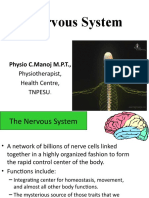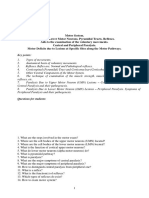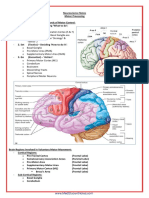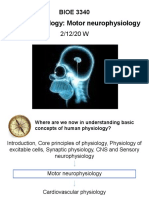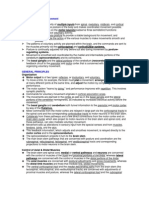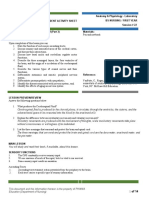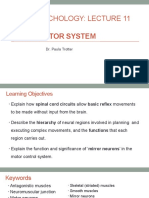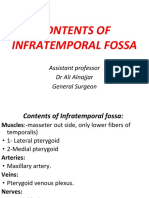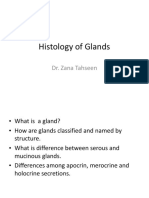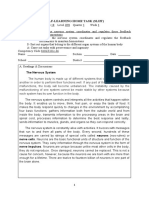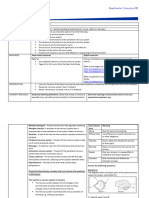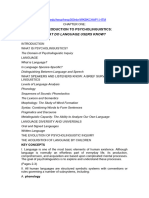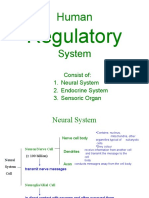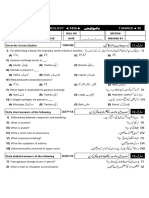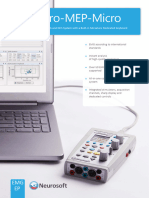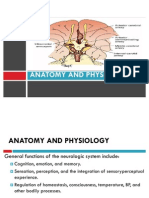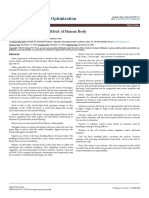L1 Motor Function of CNS
Uploaded by
Ahmed JawdetL1 Motor Function of CNS
Uploaded by
Ahmed JawdetMotor
Function of CNS
By
Assistant Professor of Neurology
Dr. Mufeed Akram Taha
FIBMS Board Neurology
Most “voluntary” movements initiated by
the cerebral cortex are achieved when
the cortex activates “patterns” of
function stored in lower brain areas—the
cord, brain stem, basal ganglia, and
cerebellum. These lower centers, in turn,
send specific control signals to the
muscles.
The motor functions of CNS can be divided into:-
• Movement in which subdivided into 3 types of
movement
1. Voluntary movement like playing
piano&writing
2. Reflexes which are involuntary, rapid,
stereotyped movement like eye blinking,
Knee jerk.
3. Rhythmic motor pattern like chewing,
walking and running.
• Posture and balance
• communication
MOTOR CORTEX
The motor cortex occupies posterior third of
frontal lobe anterior to the central sulcus
(precentral gyrus).
The motor cortex itself is divided into three
subareas, each of which has its own
topographical representation of muscle
groups and specific motor functions:
(1) the primary motor cortex,
(2) the premotor area
(3) the supplementary motor area.
Primary Motor Cortex:-
The primary motor cortex lies in the first convolution of
the frontal lobes anterior to the central sulcus.This
area is responsible for conscious voluntary control of
precise, skilled movements of either individual
muscles or small groups of muscles. The extremities
of the opposite side of the body are represented in
the precentral gyrus, with the feet at the top of the
gyrus and the face at the bottom.
The cortical representation of each part of the body is
proportional to the skill with which the part is used in
fine voluntary movement, so more than one half of
the entire primary motor cortex is concerned with
controlling the muscles of the hands and speech.
Supplementary Motor Area
This is located on medial surface of the
frontal lobe slightly anterior to the
primary motor cortex. it is responsible
for global mental planning of complex
motor sequences and sends these
instructions to the premotor area.
Premotor Area
This is located anterior to primary motor area
and below the supplementary motor area on
the lateral side of the hemisphere.Nerve
signals generated in the premotor area cause
much more complex “patterns” of movement
than the discrete patterns generated in the
primary motor cortex. For instance, the
pattern may be to position the shoulders and
arms so that the hands are properly oriented
to perform specific tasks.
• Within the premotor cortex the following
areas are present:-
1. Broca’s area for speech(this is the word
formation area).
2. Voluntary Eye Movement area: Located in
the premotor area immediately above Broca’s
area. Damage to this area prevents a person
from voluntarily moving the eyes toward
different objects.
3. Head Rotation Area:This area is closely
associated with the eye movement field; it
directs the head toward different objects.
4. Hand Skills Area: Located in the
premotor area immediately anterior to
the primary motor cortex for the hands
and fingers when there is damage to this
area hand movements become
uncoordinated and nonpurposeful.
Transmission of Signals from the Motor
Cortex to the Muscles
Motor signals are transmitted directly from the
cortex to the spinal cord through the
corticospinal tract and indirectly through
multiple accessory pathways that involve the
basal ganglia, cerebellum, and various nuclei of
the brain stem.
The higher motor control systems
This control systems involve the structure control
all motor activities executed at the brain stem
level and spinal cord and these are :
1-The pyramidal system.
2- The extrapyramidal system.
3- The cerebellum.
The pyramidal and extrapyramidal systems called
upper motor neurons.
Corticospinal (Pyramidal) Tract:-
The corticospinal tract originates about 30%
from the primary motor cortex, 30% from the
premotor and supplementary motor areas,
and 40% from the somatosensory areas
posterior to the central sulcus. After leaving
the cortex, it passes through the internal
capsule and then downward through the brain
stem forming the pyramids of the medulla.
The majority of the pyramidal fibers 80% then cross in the
lower medulla to the opposite side and descend into
the lateral corticospinal tracts of the cord, finally
terminating on excitatory (for the agonist muscle) or
inhibitory (for the antagonist muscles) interneurons,
these fibers are concerned with distal limb muscles and
hence with skilled movements especially of hands &
fingers.
A few of the fibers do not cross to the opposite side in the
medulla but pass ipsilaterally down the cord in the
ventral corticospinal( these fibers are concerned with
axial and proximal limb muscle contraction).
Glutamate and or aspartate is the neurotransmitter of the
pyramidal system.
The extrapyramidal system:-
Which includes all those portions of the brain
and brain stem and their fibers that
contribute to motor control but that are not
part of the direct pyramidal system. This
system is concerned mainly with:
• Postural control and stability.
• Inhibits unwanted muscular activity.
• Maintains muscle tone.
Extrapyramidal system includes:
• Basal ganglia
• Reticular formation
• Vestibular nuclei
• Red nuclei
• Substantia nigra
• Tectum
• Subthalamic nucleus
• Cerebellum
When a firm tactile stimulus is applied to lateral
sole of the foot, two reflex arcs are stimulated at
the same time one through pyramidal system
and the other through extrapyramidal system, In
normal condition, the reflex arc of the pyramidal
system suppresses that of extrapyramidal system
and therefore downward bending of the toes is
elicited when tactile stimulus is applied to lateral
sole of foot. When pyramidal system is
dammaged without extrapyramidal system there
will be extension of great toe and fanning of
other toes called Babinski sign.
The main spinal extrapyramidal tracts include
the subcorticospinal pathways which are:-
1. Tectospinal tract(from the superior
colliculus of the tectum and is involved in
the control of neck muscles).
2. Vestibulospinal tract(from vestibular
nuclei)
3. Reticulospinal tracts(from pontine and
medullary reticular formation)
4. Rubrospinal tract(from the red nucleus)
The red nucleus:-
It’s oval nucleus, pink in fresh specimens bec. of an
iron containing pigment in many of the cells and
its centrally placed in the upper mesencephalic
reticular formation.It receives fibers from the
deep cerebellar nuclei and cerebral cortex and
the most important efferent projection of the red
nucleus is to the contralateral spinal cord. It
operates in close association with the pyramidal
tract. This nucleus give rise to rubrospinal tract
that cross to opposite side in lower brain stem
and follows a course parallel to the lateral
corticospinal tract and it acts as an accessory
route for the transmition of discrete signals
from the motor cortex to the spinal cord.
This tract is involved in large movements of
proximal musculature of the limbs. It
inhibits activity of extensors and increases
activity of flexors.
Role of the Brain Stem in Controlling Motor Function
The brain stem consists of the medulla, pons, and
mesencephalon.
it provides many special control functions, such as the
following:
1. Control of respiration
2. Control of the cardiovascular system
3. Partial control of gastrointestinal function
4. Control of many stereotyped movements of the body
5. Control of equilibrium
6. Control of eye movements.
Motor Functions of the Spinal Cord
"Spinal Cord Reflexes“
The basic unit of integrated reflex activity is
the reflex arc. This arc consists of a sense
organ, an afferent neuron, one or more
synapses in a central integrating station or
sympathetic ganglion, an efferent neuron,
and an effector. The connection between
afferent and efferent somatic neurons is
generally in the brain or spinal cord.
The sensory signals enter the cord almost entirely
through the sensory (posterior) roots. After
entering the cord, sensory signal travels to two
separate destinations:
(1) One branch terminates in the gray matter of the
cord to elicits local segmental cord reflexes and
other local effects.
(2) Branch transmits signals to higher levels (Brain
stem, cerebral cortex).
Each segment of the spinal cord has several million
neurons in its gray matter which are of 3 types:
(1) Sensory relay neurons
(2) anterior motor neurons Located in the anterior
horns of the spinal cord. They give rise to the nerve
fibers that leave the cord by the anterior roots and
directly Innervate the skeletal muscle fibers(The
lower motor neuron).
The anterior motor neurons are of 2 types:
A. The alpha motor neurons: which give off large
nerve fibers (Type A alpha nerve fiber) that
innervate the large skeletal muscle fibers forming
the motor units.
B. The gamma motor neurons: which give off nerve
fibers (Type A gamma nerve fiber) that innervate
very small special skeletal muscle fibers called
intrafusal fibers which are part of muscle spindle.
(3) interneurons: These are small neurons
that have many interconnections one
with the other. Most of incoming sensory
signals from the spinal nerves are
transmitted first through interneurons
where they are appropriately processed
and then terminate on the anterior
motor neurons and are responsible for
most of the integrative functions of the
spinal cord.
The Muscle receptors and their roles
in muscle control
Proper control of muscle requires not only
excitation of the muscle by the anterior motor
neurons but also continuous feedback of
information from each muscle to the nervous
system which is achieved by two special types
of sensory receptors and these are:-
1. Muscle spindle: Which are distributed
throughout the belly of muscle and which send
information to the NS about the muscle length
and the rate of change of it’s length.
Figure shows the main component of muscle spindle
-Each muscle spindle consists of up to about 10
muscle fibers enclosed in connective tissue
capsule.
They are parallel to other muscle fibers and they
are called intrafusal fibers.
-The spindle have a motor nerve supply of their
own. These neurons are small gamma neurons
called efferent Gamma neurons and these
constitute 30% of fibers in the anterior root
nerves.
-Muscle spindle supplied by sensory afferent nerves
of type Ia (rapid conducting) and type II nerve
fibers.
- There are 2 types of intrfusal fibers and these
are nuclear chain fibers ( which detect the
changes in length i.e static changes) and nuclear
bag fibers (which detect the rate of change in
muscle i.e dynamic changes).
- The receptor portion of the muscle spindle is
stimulated by stretch of the midportion of the
spindle.
2. Golgi Tendon Organ:
• This is an encapsulated sensory receptor
through which muscle tendon fibers pass.
About 10 to 15 muscle fibers are usually
connected to each Golgi tendon organ.
Signals from tendon organ transmitted by
large rapidly conducting type Ib nerve fibers.
• Golgi tendon organ detects tension in the
muscle i.e. stimulated when there is
increased tension of muscle fibers and its
stimulation cause inhibitory effect.
The Golgi tendon reflex (inverse
stretch reflex)
Figure shows Golgi tendon organ
Muscle Stretch Reflex
The simplest manifestation of muscle spindle function
is the stretch reflex. Whenever a muscle is stretched
suddenly, excitation of the muscle spindles causes
reflex contraction of the large skeletal muscle fibers
of the stretched muscle and also of closely allied
synergistic muscles.
-The neuronal circuit of stretch reflex consist of muscle
spindle from which signal transmitted by sensory
nerve fiber to dorsal root of spinal cord and from
there branch of this fiber goes directly to anterior
horn and synapse with anterior motor neuron that
send motor nerve fiber back to the same muscle
from which muscle spindle originated; therefore,
this reflex is monosynaptic reflex.
The muscle strech reflex is controlled by higher areas
of brain through gamma efferent system which is
excited specifically by signals from the bulboreticular
facilitatory region of the brain stem and, secondarily,
by impulses transmitted into the bulboreticular area
from (1) the cerebellum,
(2) the basal ganglia, and (3) the cerebral cortex.
An important function of the stretch reflex is its ability
to prevent oscillation or jerkiness of body
movements. This is a damping, or smoothing
function.
Other important functions of the muscle spindle
system is to stabilize body position during tense
motor action.
Golgi tendon reflex:
When the Golgi tendon organs of a muscle
tendon are stimulated by increased tension in
the connecting muscle, signals are transmitted
to the spinal cord to cause reflex effects in the
respective muscle. This reflex is entirely
inhibitory. This reflex provides a negative
feedback mechanism that prevents the
development of too much tension on the
muscle.
Comparison Between Stretch &
Inverse Reflexes
Flexor Reflex and the Withdrawal Reflexes
Stimulation of cutaneous sensory receptor by any stimuli
especially by painful stimulus in a limb cause the flexor
muscles of the limb to contract, thereby withdrawing
the limb from the stimulating object.
This is called the flexor reflex, this reflex also called pain
reflex. If some part of the body other than one of the
limbs is painfully stimulated, that part will similarly be
withdrawn from the stimulus, but the reflex may not be
confined to flexor muscles, even though it is basically
the same type of reflex. Therefore, the many patterns
of these reflexes in the different areas of the body are
called withdrawal reflexes.
The withdrawal reflex is polysynaptic reflex i.e.
the pathway for eliciting the flexor reflex do
not pass directly to the anterior motor
neurons but instead pass first into the spinal
cord interneuron pool of neurons and then
pass to the motor neurons. The shortest
possible circuit is a 3- or 4-neuron pathway.
Thank You
You might also like
- Exercise 8 Pig Embryo (Posterior Sections)No ratings yetExercise 8 Pig Embryo (Posterior Sections)16 pages
- Lesson 3 He Neuromotor Basis For Motor ControlNo ratings yetLesson 3 He Neuromotor Basis For Motor Control46 pages
- PHYSIO - P9 - Cortical and Brain Stem Control of Motor Function.docxNo ratings yetPHYSIO - P9 - Cortical and Brain Stem Control of Motor Function.docx6 pages
- PHYSIOLOGY Chapter 56 Cortical and Brain Stem Control of Motor FunctionNo ratings yetPHYSIOLOGY Chapter 56 Cortical and Brain Stem Control of Motor Function11 pages
- Lesson 3 The Neuromotor Basis For Motor Control v2100% (1)Lesson 3 The Neuromotor Basis For Motor Control v211 pages
- Lesson 3 The Neuromotor Basis For Motor ControlNo ratings yetLesson 3 The Neuromotor Basis For Motor Control47 pages
- Physiology of Motor Control in Action SystemNo ratings yetPhysiology of Motor Control in Action System33 pages
- ASLI - 20.10.2022NMD-5 Anatomy of Motor ControlNo ratings yetASLI - 20.10.2022NMD-5 Anatomy of Motor Control40 pages
- Motor System: Asma Hayati Ahmad Department of PhysiologyNo ratings yetMotor System: Asma Hayati Ahmad Department of Physiology47 pages
- Neurophysiology: Motor Neurophysiology: BIOE 3340No ratings yetNeurophysiology: Motor Neurophysiology: BIOE 334060 pages
- motor cortex and pyramidal tract editedNo ratings yetmotor cortex and pyramidal tract edited39 pages
- 3. Motor functions of the CNS- PhysiologyNo ratings yet3. Motor functions of the CNS- Physiology67 pages
- CogBio - Lecture 11 - Motor System - Student - PDTNo ratings yetCogBio - Lecture 11 - Motor System - Student - PDT22 pages
- Gale Researcher Guide for: Overview of Physiology and NeuropsychologyFrom EverandGale Researcher Guide for: Overview of Physiology and NeuropsychologyNo ratings yet
- Self-Learning Home Task (SLHT) : The Nervous System100% (1)Self-Learning Home Task (SLHT) : The Nervous System11 pages
- NCERT Exemplar Ques Ans Class10 Control N CoordinationNo ratings yetNCERT Exemplar Ques Ans Class10 Control N Coordination21 pages
- Nervous System: Science 6 - Second QuarterNo ratings yetNervous System: Science 6 - Second Quarter25 pages
- Life Sciences Grade 12 Term 3 Week 1 - 2020No ratings yetLife Sciences Grade 12 Term 3 Week 1 - 20208 pages
- Fundamentals of Nervous System and Nervous TissueNo ratings yetFundamentals of Nervous System and Nervous Tissue37 pages
- Weakness and Hypotonia: Prepared by DR Hodan Jama MDNo ratings yetWeakness and Hypotonia: Prepared by DR Hodan Jama MD38 pages
- (Ebook) The human nervous system: structure and function by Charles R. Noback, David A. Ruggiero, Robert J. Demarest, Norman L. Strominger ISBN 9781588290397, 9781588290403, 1588290395, 1588290409 instant downloadNo ratings yet(Ebook) The human nervous system: structure and function by Charles R. Noback, David A. Ruggiero, Robert J. Demarest, Norman L. Strominger ISBN 9781588290397, 9781588290403, 1588290395, 1588290409 instant download48 pages
- Unit 6 Interaction (II) : The Endocrine and Nervous System: 3 of Secondary EducationNo ratings yetUnit 6 Interaction (II) : The Endocrine and Nervous System: 3 of Secondary Education33 pages
- Instant Ebooks Textbook Practical Guide To Exercise Physiology Bob Murray Download All Chapters100% (4)Instant Ebooks Textbook Practical Guide To Exercise Physiology Bob Murray Download All Chapters62 pages
- Fundamental Neuroscience for Basic and Clinical Applications Duane E. Haines All Chapters Instant Download100% (1)Fundamental Neuroscience for Basic and Clinical Applications Duane E. Haines All Chapters Instant Download55 pages




